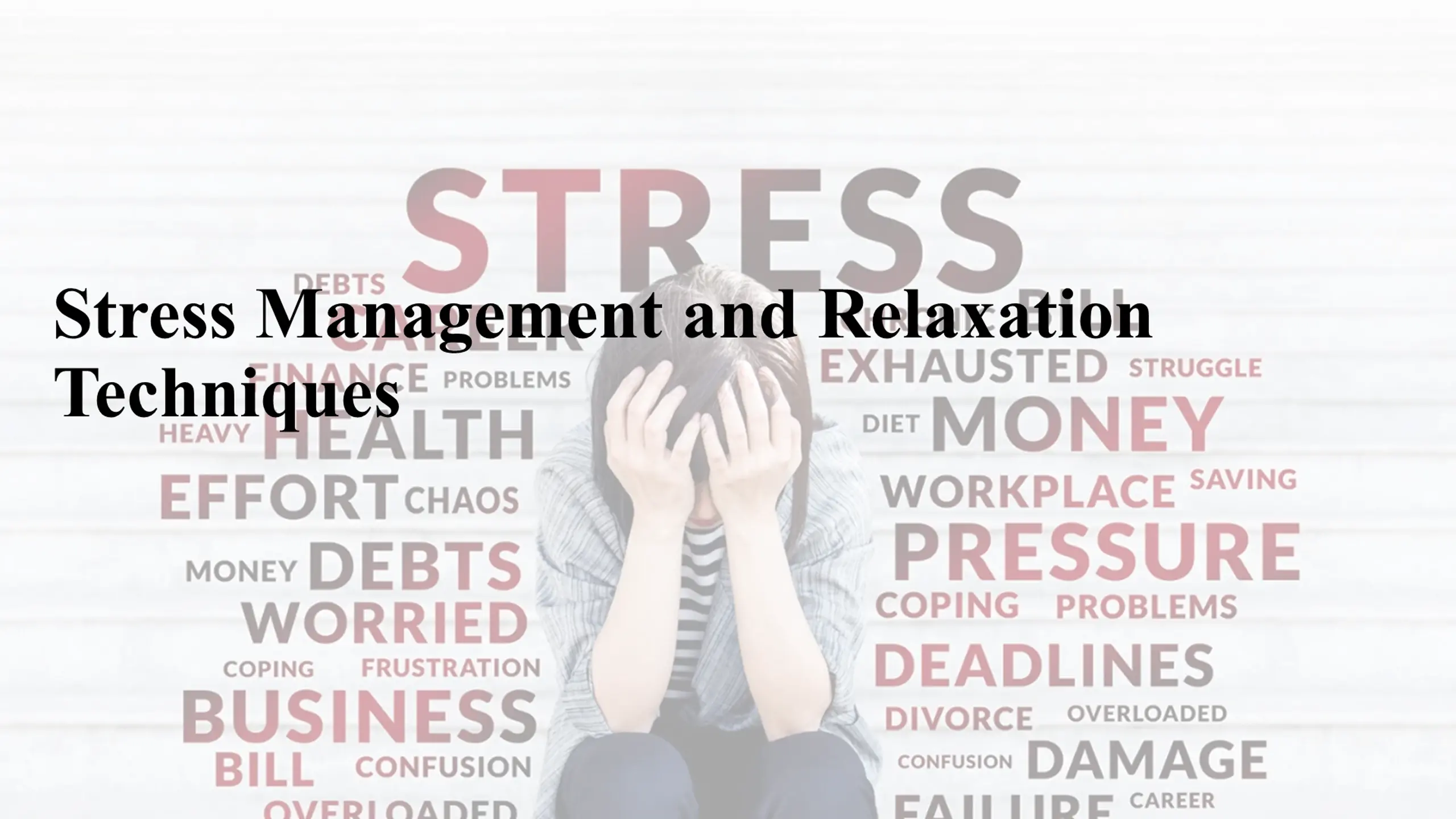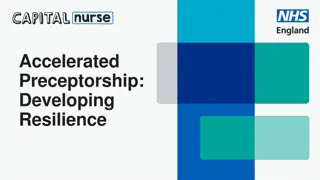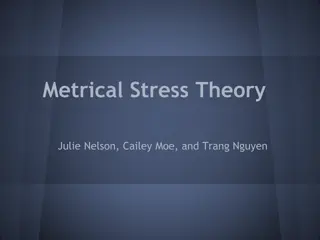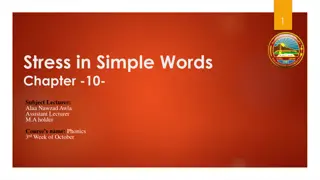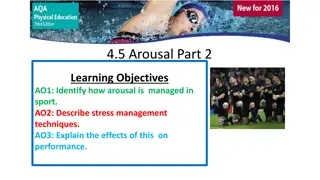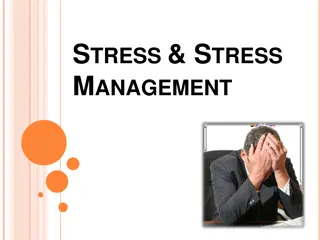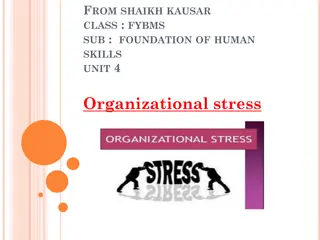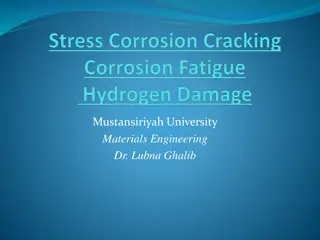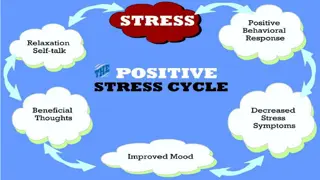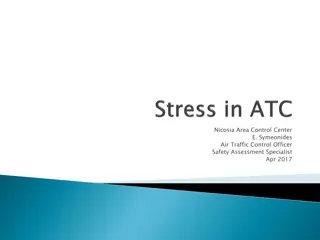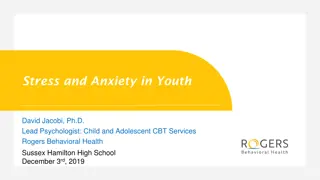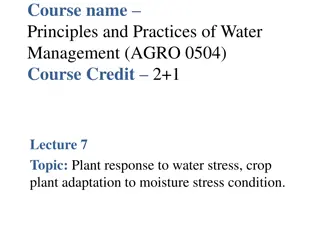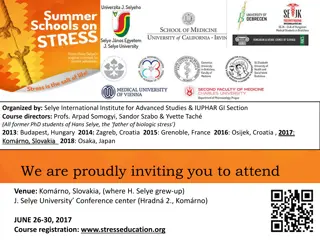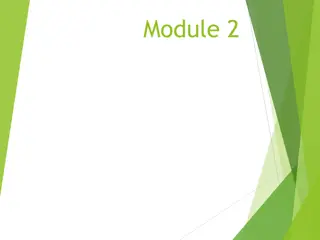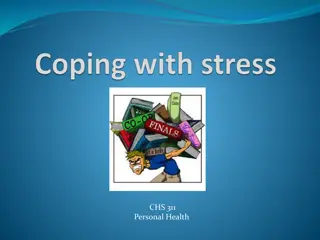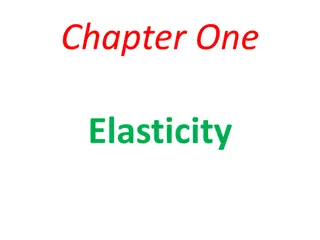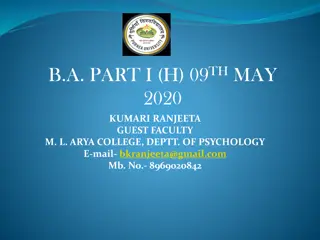Effective Stress Management Techniques
Explore the various facets of stress, from its definition to its features, and learn how stress can be both positive and negative. Understand that stress is relative, temporary, and unavoidable, but can be managed effectively through relaxation techniques. Popular
Download Presentation

Please find below an Image/Link to download the presentation.
The content on the website is provided AS IS for your information and personal use only. It may not be sold, licensed, or shared on other websites without obtaining consent from the author.If you encounter any issues during the download, it is possible that the publisher has removed the file from their server.
You are allowed to download the files provided on this website for personal or commercial use, subject to the condition that they are used lawfully. All files are the property of their respective owners.
The content on the website is provided AS IS for your information and personal use only. It may not be sold, licensed, or shared on other websites without obtaining consent from the author.
E N D
Presentation Transcript
Stress Management and Relaxation Techniques
Definition of Stress According to Beehr and Newman, Stress is a condition arising from the interaction of people and their jobs and characterized by changes within people that force to deviate from their normal functioning . According to Fred Luthans, Stress is an adaptive response to an external situation that results in physical, psychological and behavioral deviations for organization participants . Ivancevich and Matteson has defined stress as, An adaptive response, medicated by individual characteristics and/or psychological processes, that is a consequence of any external action, situation or event that place special physical and or psychological demands upon a person.
Features of Stress Stress can be positive Stress can be negative Stress is Relative Stress is temporary Stress remains for life time in some form or other Stress can affect health Stress is unavoidable but can be managed Stress may result into any kind of deviation Stress may be result of individuals interaction with environment stimuli
Stress can be positive Stress can be good or positive as it can motivate one in making major changes in their life or to find a solution to the problem. It can make the person excited for taking a challenge or doing something for the first time. It can also be termed as Eustress or good stress. It has a feeling excitement and nervousness or fear at the same time. For example, a child going to school for the first time is excited of making new friends but at the same time is nervous of being accepted by the people.
Stress can be negative This is an unhealthy stress which can be termed as bad stress or dis-stress or dysfunctional. This stress may lead to a person feeling angry, sad or scared. Example: A child changing school may experience unhealthy stress as he is upset of leaving old friends and scared of making new friends at the new place. Similarly, when a person has to appear for an interview unhealthy stress as he is scared of his performance at the interview and may feel tensed and nervous till the time his interview is over. he suffers from
Stress is Relative Stress is different for every individual. Some people are extrovert and enjoy being social whereas the introvert people will feel comfortable when in isolation. For extroverts giving presentations in public is a regular activity but at the same time for an introvert it may cause stress and nervousness.
Stress is temporary Stress is for short term. It will be for a short while. Once your work is done the stress disappears. Example: A person enters a wrong CVV number while making payment through credit card and is not able to process the payment. The stress would remain till the time the problem persists.
Stress remains for life time in some form or other Stress is a part of everyone s life. It is experienced in everyday life and hence one should try to manage stress in order to live a healthy life.
Stress can affect health Stress can cause health problems among individuals. One can suffer from ulcers, insomnia, common cold, blood sugar, blood pressure, cholesterol etc.
Stress is unavoidable but can be managed Stress is a part of everyone's life. People face different kinds of stress such as family, parental, job; financial, educational etc. One can manage such stress by listening to music, meditation, exercise, reading books, talking to friends, indulging in hobbies etc. It can also be managed by being more disciplined and organized.
Stress may result into any kind of deviation Stress may result into physical, psychological, or behavioral deviations in the person. This deviation is from day to day activities that are accompanied due to anxiety.
Stress may be result of individuals interaction with environment stimuli Such stimuli may be in any form interpersonal interaction, event, etc. The impact of the stimuli produces deviation in the individual.
Physical Stress Emotional Stress Psychological Stress Types of Acute Stress Stress Chronic Stress Distress Eustress Hyper stress Hypo Stress Hassles
Types to Stress Stress levels differs from person to person. Some people have high stress tolerance level and hence able to perform well in stressful circumstances. On the other hand, there are people having low stress tolerance level and hence unable to cope up in stressful circumstances. The following are the types of stress are: 1) Physical Stress 2) Emotional Stress 3) Psychological Stress 4) Acute Stress 5) Chronic Stress 6) Distress 7) Eustress 8) Hyper stress 9) Hypo stress 10) Hassles
Physical Stress Physical stress occurs when the body as a whole suffers stressful symptoms experiences are headaches, pain in neck, shoulders, muscles, forehead, etc. It can also cause symptoms such as ulcers, nervousness, heart sweating, hair loss, etc. situations. The ailments, excessive
Emotional Stress Emotional stress is a state of mental or emotional strain resulting from adverse or demanding circumstances. It occurs when an individual feels overwhelmed, anxious, or unable to cope with the pressures they're facing. This type of stress can arise from various sources such as work, relationships, financial issues, traumatic events, or major life changes. When under emotional stress, symptoms like irritability, mood swings, difficulty concentrating, changes in appetite, disturbed sleep patterns, and physical symptoms like headaches or muscle tension. It's essential to manage emotional stress as prolonged exposure to high levels of stress can have adverse effects on both mental and physical health. Strategies to manage emotional stress include practicing relaxation techniques (like meditation or deep breathing), regular exercise, maintaining a healthy lifestyle, seeking support from friends or family, and, if needed, professional help from therapists or counselors. people might experience
Psychological Stress Psychological stress refers to the emotional and mental strain experienced when an individual perceives that the demands placed upon them exceed their ability to cope. It's often linked to the perception of an event or situation as threatening or overwhelming, leading to a stress response. This type of stress can arise from various sources such as work, school, relationships, financial pressures, major life changes, or traumatic events. Psychological stress can be due to long term stress. The symptoms can be isolation, phobias, night terrors, eating disorders.
Acute Stress Acute stress is of short duration and related to threating events which is also called as on the spot stress. It results from specific situations that include threat, poor sense of control. It s a stress that may occur while fighting with a colleague over an issue.
Chronic Stress It is a type of stress that is for long duration. This type of stress effects the mind and body that may result into diseases such as heart problems, diabetes, blood pressure, cholesterol, etc. It may occur at workplace due to the repeated and irritating behavior of the boss.
Distress Distress is a type of negative stress that occurs by changes in the routine activities of an employee. It results in frustration, lack of concentration, physical and mental health, etc. It occurs due to frequent changes in the job. Distress is the unhealthy and negative stress response that denotes the presence of high level of stress in an individual which affects his performance and efficiency increasing errors, bad stomach problems and psychosomatic illnesses. that leads insomnia, to decisions,
Eustress It is a type of stress that is healthy and positive. It improves the enthusiasm, creativity, productivity. It is a curative stress that helps employees to give good performance. It motivates them to accept challenges and achieve success. This may lead employees to new and better ways of doing their work. It denotes the presence of optimum level of stress in an individuals. Under optimum level of stress the employee will perform to his full capacity. Then the individual gets bored, the motivational level of work, reaches a low point and apathy sets in. If one operates in very low stress environment and constantly experiences boredom the person is likely to be psychological withdrawal will result in careless mistakes being frequently made, forgetfulness and withdrawal will manifest itself in increased rate of tardiness and absenteeism which will ultimately lead to turnover. absent-mindedness. Physical
Hyper stress This stress occurs when a person cannot handle and is under pressure to completer a task. It results from being overloaded or overworked. A person experiences this type of stress due to heavy workloads and deadlines given to them. It is another form of negative stress. Examples include highly stressful jobs, which requires longer working hours than the individual can handle. If a person is suffering from hyper stress, he is likely to have sudden emotional breakdown over irrelevant issues. It is important to recognize that human body needs a break, of one may end up with severe and chronic physical and psychological reactions.
Hypo stress This type of stress occurs when a person is bored of doing the routine job everyday and as a result become restless and uninspired. This is due to an insufficient amount of stress. Companies should avoid having workers who experience hypo stress as this will affect the quality of work and productivity. There should always be a job rotation so that a person can learn something new and can avoid boredom and repetitive jobs.
Hassles Hassles cribbing's of everyday life. It occurs due to inability to make decisions, meeting of deadlines, confrontations with the boss, reaching late to office due to heavy traffic, etc. It affects their mood and health are minor irritations and
Relation between Stressors and Stress Stress Stressors Stressors physically circumstances. Stressors tend to increase susceptibility to physical illness such as heart diseases, as well as psychological problems such as anxiety and depression. It tends to affect health more when they are chronic, highly perceived as uncontrollable. Types of stressors: individual, group, organizational and extra organizational. are demanding psychologically or or Stress is the physical, mental and emotional human particular stimulus, otherwise called as stressor . It is the adoption/coping response that helps the body challenging situations. Stress can be either positive, depending on the stressor Types of stress: destructive, chronic, positive, negative, episodic. events response to a to prepare for negative or disruptive, or constructive,
Potential Sources of Stress: Job stress is not limited to things that happen inside the organization, during the working ours. The sources of stress are as follows: A) Environmental: Some stress that people experience in the workplace is related to the physical environment is which they work. This type of stress can be associated with workplace safety issues, the configuration of one s work area, the type of furniture or equipment that must be used in order to perform job functions, and other variables. The following factors leading to environmental stress: 1) Political Factors: There may be political uncertainties in the country that may lead to stress. Countries will have stable political system where changes are implemented in a proper way. 2) Economic Factors: Economic uncertainties are created by changes in the business cycle. The security of the people comes to a stake when the economy contracts. Minor recessions also leads to stress in the work force as there are reductions in the workforce, temporary layoff, reduction in pay and so on. 3) Technological Factors: Technological uncertainty is the third type of environmental factor that can cause stress. In today s era of technological development new innovations make an employee s skills and experience obsolete in a very short span of time. Computers, automation are other forms of technological innovations, which are threat to many people and cause them stress.
Potential Sources of Stress B) Organizational: There are several factors in an organization that causes stress. Every aspect can be a stress for someone or the other. Another source of stress in organizations is poor interpersonal relationships or conflicts. These conflicts can be among the members of the group or between the superiors and subordinates. Groups have a lot of influence on the employees behavior, performance and job satisfaction. The following are the factors in the organization that have some influence on the extent of stress the people influence at the workplace: These factors include the following: 1) Boredom: An individual may experience stress is the job that he is doing is of routine nature that will result in boredom and fatigue. He may be stressed on the other hand. If the job demands more of travelling, frequent transfers and less time with his family. 2) Organizational Climate: Much of the group or interpersonal relationships depend upon the organizational climate. An overall organizational climate may have a relaxed style of working or it may be tense and crisis oriented. All the employees of such organization will be continuously tense, if the climate in general is unfriendly, hostile or totally task oriented. 3) Risk involved: Some jobs are unethical or risk of life is involved in it will also lead to stress. A person may take up such job as he is unable to get good opportunities and hence forced to take up something for survival of his family. This will affect the peace of mind of the employee. 4) By Default: Some job such as fighter or polices squad which defuses bomb have duties and responsibilities that creates stress by default. 5) Conflicts: People who are working in the organizations are prone to interpersonal and intergroup conflicts. Conflicts has both functional and dysfunctional aspects. Whenever conflict has dysfunctional consequences, it will lead to stress in all the concerned parties.
Potential Sources of Stress 6) Anxiety: Stress may be due to anxiety where people are working in a noisy environment, unfavorable temperatures and working conditions, remote locations, overcrowded room, constant interruptions, etc. 7) Interdependence: Interdependence on others for every work reduces confidence among individuals to work and cause stress. There is no freedom for them to work as per their creativity and talent. 8) Lack of job security: Stress can be a major concern when there is no job security. An individual is always under the fear of losing the job that affects the concentration level of work and quality. 9) Overload of work: Overloading of work causes stress. A person is given work more than he is capable of handling. It can be both qualitative overload of work and quantitative. In qualitative overload the person is not confident of his capability to do a specific task, on the other hand quantitative overload means a person has to perform too many tasks or very little time to complete the task. 10) Undesirability: It may lead to boredom that causes tension and anxiety, a moderate degree of work related stress is optimal because it leads to high level of energy and motivation.
Potential Sources of Stress C) Individual: Normally an individual works for 8-10 hours a day, when he works more than 14 hours the stress level starts occurring. The factors that cause individual stress as follows: 1) Job concerns: Lack of job security leads to concern, anxiety or frustration to the individuals. The fear of losing a job especially when a person is the sole bread owner in the family becomes very stressful. Career progress is another reason of anxiety. It is mainly in the case of middle aged people where they felt demotivated in case if they were not promoted to the next level due for them or were given a position that was less than their experience and qualifications. 2) Career Changes: Transfers may lead to stress as it affects the entire routine of a person. A person has to relocate to new place, adjust to the new environment i.e. the working pattern, lifestyle, culture, language, etc. and sometimes even have to stay for work without his family. It causes the following fears in an individuals mind: i) The fear of working in a new location. ii) Unpredictability about new work environment. iii) Anxiety about creating new relationships. iv) Uprooting of children from their schools and friends. v) If the employee has got a working spouse then the stress is greater. 3) Economic Problems: Some people are impulsive buyers, they do not manage funds appropriately and are always having desires and wants that are more than their capacity of earnings. Stress automatically occurs when a person spends more than he earns and it leads to tension, distraction at work. 4) Changes in Life Structure: The demands of a person changes from time to time. The lifestyle changes as per the age. As he becomes older his responsibilities increases that leads to stress. 5) The Pace of Life: As a hectic pace of life when the person is always busy in business or otherwise can create more stress than a relaxed pace of life. Certain professions like teaching are less stressful than those of company executives, bankers or businessman.
Potential Sources of Stress 6) Life Change and Life Traumas: Life change and life traumas are both stress producing. Life changes may be slow (like getting older) or sudden (like the death of a spouse). Sudden changes are highly stressful. Life traumas can be highly stressful.Alife trauma is any distraction in an individual s life that alters his or her attitudes, emotions or behaviours. 7) Personality of a Person: The extent of stress is also determined by the personality of a person. In respect of personality the distinction between TYPE A and TYPE B behavior pattern becomes relevant. TYPE A personalities may create stress in their work circumstances due to their achievement, orientation, impatience, and perfectionism. TYPE A people thus, encounter more stress. TYPE B personality on the other hand are less stress prone. 8) Ability to cope: The ability of the person to cope with stress and the sources a person seeks to deal with stress are also very important. For example, people who have strong faith in God and his will find it easier to deal with stressful situations like the loss of a loved one. 9) Role Conflict: Role conflict is two or more persons have different and sometimes opposing expectations of a given individual role conflict occurs. Thus, there are two or more set of pressures on the individuals so that it is not possible to satisfy all of them. Role conflict takes place when contradictory demands are placed upon an employee simultaneously. For example, an advertising manager may be asked to produce a creative ad campaigns while on the other hand, time constraint is put upon him, both roles being in conflict with each other. Another type of role conflict is the inter-role conflict where an individual plays more than one role simultaneously in his life and the demands of these roles conflict with each other. 10) Role Ambiguity: Stresses from job ambiguity arise when an employee does not know what is expected of him or her or how to go about doing the job. For example, if a new recruit is not explained his role clearly then he is likely to face role ambiguity.
Potential Sources of Stress 11) Role Overload: Role Overload refers to the situation when an individual is expected to do too many things within a limited time as part of the daily routine. For example, if Mrs. X is expected to perform the duties of a supervisor, receptionist, public relations officer and an accountant, she is likely to experience a lot of stress from several roles she has to play during the day. She may be able to manage the various roles for a short period of time, but if expected to continue in this fashion on a long term basis, she is likely to fall sick or quit. 12) Inter Personal and Group Related Factors: Interpersonal demands are pressures created by other employees. Group related stressors include factors like conflicts, poor communication, unpleasant relationship and fear of being ostracized from the group as a valued member. Working with superior, peers or subordinates with whom one does not get along can be a constant source of stress. Some people can deal with conflicts and misunderstandings in an open way and resolve issues as they arise. Many however, find it difficult to do this and build internal stresses for themselves.
Consequences of Stress The degree of stress experienced by an individual depends on the employee s perception and the manner in which the person reacts in that situation. The following are the consequences of stress: A) Physiological consequences: Physiological stress can be due to long term stress. The symptoms can be isolation, phobias, night terrors, eating disorders. The physiological consequences include high blood pressure, sweating, hot and cold flashes, headaches and gastrointestinal disorders. Stress related individuals affect both individuals and organizations. The cost of it is borne by both the parties. At organization, the cost of employer can be at three different levels: i) An employer has to pay for the serious illness such as heart related sickness. ii) Cause of accidents at the workplace is due to emotional disturbances of the employee. iii) Legal hassles between the employee and the employer because of the stress related compensation claims. B) Psychological consequences: Excessive stress can result in boredom, dissatisfaction, anxiety, tension, irritability and depression. All these make an individual having a feeling of sickness and result in poor concentration, indecision and decreased attention at work. This result in negative attitude of people such as anger, frustration, lack of concentration, indecisiveness, forgetfulness, criticisms, negative thinking, living in a fantasy world etc. This may result into Job Burnout which is as a result of excessive stress at work. Burnout can be due to emotions, detachment from work, unable to accomplish goals. It may lead due to factors such as work overload, interpersonal conflicts, lack of control over responsibilities, inadequate recognition for one s work.
Consequences of Stress C) Behavioral consequences: Negative stress results in accidents at work place and also affects the job performance of employees. High stress damage one s ability to remember information. Make effective decisions and take appropriate actions. Sleep disorders, changes in eating habits, increase in smoking and alcohol consumption, nervous behavior such as rapid speech. Stuttering and rude behavior towards others. It can cause polite and sober people also to shout at their colleagues out of frustration, violence at the workplace resulting in suicide and physical attacks on one another.
Burnout - Concept It is a negative stress which is experienced by people who suffer stress for a long duration of time. Burnout can be due to emotions, detachment from work, unable to accomplish goals. It may lead due to factors such as work overload, interpersonal conflicts, lack of control over responsibilities, in adequate recognition for one s work. It has three aspects as under: a) Exhaustion: It involves low energy, weakness and fatigue. b) Cynicism: It involves negative attitude towards self, work and life in general. c) Reduced Self-efficacy: It involves declining feelings of competence at work that may lead to hopelessness and helplessness. d) People suffering from burnouts lead to consequences such as: i) They are likely to attribute their errors to others. ii) They are highly irritable. iii) they often think of quitting their jobs or entering in new careers. iv) They have negative attitude towards work and others. v) There is increased absenteeism. vi) There is reduce productivity at work. vii) They suffer from various health issues.
Stress V/S Burnout Stress Burnout 1) In burnout there is little or no input. 1) In stress a person puts too much effort in things. 2) A person experiences emotions more strongly. 3) It causes hyperactivity. 4)Aperson has less energy. 5) It can lead to anxiety. 6) There are Physical consequences. 7) There are higher chances of early death. 8) Stress is inevitable. 2)Aperson experiences emotions flattening out. 3) It causes a helpless feeling. 4)APerson has less motivation and hope. 5) It can lead to depression. 6) There are Emotional consequences. 7) There are higher chances of hopelessness. 8) Burnout is not inevitable. 9) Burnout is the accumulation of excessive stressors over time which results in unmanageable stress levels. 9) Stress is the response.
Relaxation - Concepts An individual faces stressful situations throughout his/her life, ranging from minor disturbances like traffic jams to more serious worries. No matter what the cause, stress floods one s body with hormones. This is called as stress response . It is a normal reaction to threatening situations. It in recent times there are very less physical dangers but challenging situations that can set off the stress response. One of such ways is to invoke the relaxation response . The relaxation response is the opposite of the stress response. It s a state of profound rest that can be elicited in many ways. A relaxation technique is any method, process, procedure, or activity that helps a person to relax; to attain a state of increased calmness; or otherwise reduce levels of pain, anxiety, stress or anger. Relaxation techniques are often used to treat stress and can decrease muscle tension, lower the blood pressure and slow heart and breath rates. People respond to stress in different ways by becoming overwhelmed, depressed or both. Deep breathing exercises tend to calm people who are overwhelmed by stress, while rhythmic exercise improves the mental and physical health of those who are depressed.
Techniques of Relaxation Following are some relaxation techniques that can help one to evoke the relaxation response and reduce stress: 1) Breath focus: In this simple, powerful technique, which involves taking long, slow, deep breaths. It involves disengaging mind from stressful thoughts. Breath focus can be especially helpful for people with eating disorders to help them focus on their bodies in a more positive way. However, this technique may not be appropriate for those with health problems and that make breathing difficult, such as respiratory ailments or heart failure. 2) Body Scan: This technique combines breath focus with progressive muscle relaxation technique. After a few minutes of deep breathing, an individua needs to focus on one part of the body or group of muscles at a time and mentally releasing the physical tension. Abody scan can help boost self-awareness of the mind-body connection. If an individual has undergone recent surgery that affects one body image or other difficulties with body image, this technique may be less helpful for you. 3) Guided imagery: For this technique, one has to look for soothing scenes, places, or experiences in one s mind to help relax and focus. Free apps and online recordings of calming scenes has a lot of personal significance. Guided imagery may help one to reinforce a positive vision for oneself. 4) Mindfulness mediation: This practice involves sitting comfortably, focusing on breathing, and bringing mind s attention to the present moment without drifting into concerns about the past or the future. This form of mediation has enjoyed increasing popularity in recent years. It is helpful for people with anxiety, depression, and pain.
Techniques of Relaxation 5) Yoga, tai chi and qigong: These three ancient arts combine rhythmic breathing with a series of postures or flowing movements. The physical aspects of these practices offer a mental focus that can help distract you from racing thoughts. They can also enhance body flexibility and balance. But if an individual who is not normally active, or has health problems, may find this relaxation technique too challenging. 6) Repetitive prayer: For this technique, one has to silently repeat a short prayer or phrase from a prayer while practicing breath focus. This method may be especially appealing if religion or spirituality is meaningful to an individual. 7) Self-Hypnosis: This technique is used as vehicle to enhance the efficacy of self-suggestion. The subject plays the dual role of suggester and suggestee. Individuals who are stressed and/or lack of self-esteem can be taught self-hypnotic techniques which can induce relaxation and/or strengthen their self-esteem. It is also known as auto hypnosis technique. 8) Other Techniques: Movement based relaxation methods include exercise like walking, gardening, yoga, Tai Chi, Qigong, and more. Some forms of bodywork like massage, acupuncture, reflexology and self-regulation are helpful in promoting a state of increased relaxation. Some relaxation methods can also be used during other activities, like autosuggestion and prayer. A recent technique called as flotation therapy, makes use of a float tank in which a solution of Epsom salt is kept at skin temperature to provide effortless floating. Research has demonstrated it to be a powerful and profound relaxation technique that reduces pain and stress. Rather than choosing just one technique, experts may recommend a combination of several techniques for relaxation. But the longer and the more these relaxation techniques are practiced, the greater the benefits and the more an individual can reduce stress.
Stress Management: Concept and Features Stress is mental tension caused by demanding, taxing or burdensome circumstances. Stress not only affects our mental state and mood; it affects our physical health as well. A hormone called cortisol is released into our bloodstream, when an individual is stressed that adversely affects the digestive and reproductive system. Hence it becomes very important to practice stress management in order to keep our minds and body healthy. Stress management consists of making changes to one s life if one is in a constant stressful situation. Preventing stress by practicing self-care and relaxation and managing ones response to stressful situations when they do occur. Stress is actually a survival response when the body thinks that it is in danger. The problems is when one deals with constant stress and worry, one cannot properly manage a stressful situation. Hence stress management becomes tremendously important for health, quality of life and relationships. Thus stress management has the following features: 1) It is a process: Stress management is a process for controlling an individuals level of stress. 2) It acts as a social system: Stress management helps an individual to improve his/her mental and emotional health. It ensures speedy recovery of the individual during stressful situations. 3) Add meaning to an individuals life: Stress management not only helps individuals to overcome stress but also adds longevity and meaning to an individuals life. 4) Involves combination of techniques: Stress management may include practicing daily mediation, identifying relaxing activities, or a combination of multiple techniques. 5) Helps to maintain good health: Stress management is important because chronic stress can create havoc on one s body s immune system and contribute to health problems such as tension headaches, migraine headaches, insomnia, weight gain, depression, anxiety, digestive problems and even heart diseases. Both acute and chronic stress impact memory and concentration, making effective stress management crucial for optimal day-to-day functioning.
Benefits of Stress Management All stress is not bad. Stress needs to be managed effectively with the help of combination of various techniques. Stress when manages properly is likely to confer the following benefits to the employees in the organization: 1) Helps to build a strong company culture 2) Reduces EmployeeAbsenteeism 3) Employee retention & talent acquisition 4) Increase work commitment 5) Creates conducive work climate 6) Improves the employee employer relationship 7) Improves the quality of decision making 8) Improves organizational productivity
Benefits of Stress Management Helps to build a strong company culture: Employees have a major role in a company s culture. Healthier employees operating under manageable levels of stress will be happier and more positive, helping to maintain a strong, healthy workplace culture that would create conditions conducive to creativity and productivity. Reduce Employee Absenteeism: Stress is one of the leading causes of absenteeism in the workplace. Not only will less stress in the workplace result in less mental health days , but it will also reduces the amount of sick days taken by employees due to a weakened immune system as a result of excessive stress. Employee Retention and Talent Acquisition: Employees who are not overly stressed are much more likely to stick around, and prospective employees are much more likely to work for an employer that promotes a low-stress work environment and takes the initiative to help keep their employees healthy. Increases work commitment: Actively working to reduce stress through measures like stress management programs and policy shows company s concern for the employees. This in turn increases the commitment level of the employees towards their work. Creates conducive work climate: Every organization requires physical, financial and human resources to accomplish the goals. It is through stress management that the human resources can be motivated and can be utilized by making full use of their talent. Stress free environment increases the willingness of employees towards work leading to a workaholic climate within the organization.
Benefits of Stress Management Improves the employer employee relationship: When employees are stressed, they tend to perform less. They come in ill-tempered even when they don t mean to. This causes conflict in the workplace and spoils the atmosphere. Thus stress management ensures that the relations between the employees are not disturbed thereby making the foundations for industrial relations more stronger. Improves the quality of decision making: When an individual is stressed, there are chances that he may not take a sound decision. Workplace stress leads to demotivation and hampers productivity. Frequent occurrence of mistakes is also seen during the stressful period. However stress when managed properly not only avoids delays in decision making but also makes the employees stable and reliable. Improves organizational productivity: Employees who are stressed are less effective compared to people who have their stress under control. Chronic stress creates problems at the workplace, affecting the team s performance in the long-run. Stress management keeps people productive and increases the team s relationship and morale to the highest. Thus it can be seen that all stress not destructive. As stress level increases the individual tries to use different techniques to manage it which has a positive impact on his job performance. Employees try to tap different resources to meet the new requirements during stressful situations. Thus stress with certain limits and when managed properly can create positive effects.
Managing Stress at Individual Level High level stress affects the individual directly and through them, their families and organizations are also affected. Therefore, efforts should be made to overcome the negative consequences of high stress. Stress management is required when an individual is unable to cope with the demanding environment. This inability generates anxiety and produces defensive behaviour and stress symptoms. Therefore, certain actions are required for developing adaptive behavior so as to overcome the consequences of stress. Individual coping strategies tend to be more reactive in nature. That is, they tend to have ways of coping with stress that has already occurred. Some individual strategies, such as physical exercise, can be both reactive and proactive, but most are geared towards helping the person who is already suffering from stress. Following are the major individual coping strategies: 1) Physical exercise 2) Relaxation 3) Work-Home transition 4) Cognitive Therapy 5) Networking 6) Effective time Management 7) Foresighted nature
Managing Stress at Individual Level 1) Physical exercise: Physical exercise is a good strategy to get body fit and to overcome stress. Physical exercises of different types such as walking, jogging, swimming; playing, etc. are good methods of overcoming stress. The role of yoga, a scientific technique of physical exercise to keep body fit and to overcome stress. Personal Wellness with help of exercises is preventive mechanism to cope up with stress. It not only does increase the confidence level of the employees but also helps them to be mentally relaxed. Relaxation: Impact of stress can be overcome by relaxation. The relaxation can be simple one or some specific techniques of relaxation such as biofeedback and mediation. Biofeedback is a technique where individuals are taught to control internal body processes. Such technique requires sophisticated technology and use of computers and recording systems. Relaxation through yoga, reading, mediation helps in muscle control, thereby reducing stress to a considerable extent. Work-home transition: Work-home transition is also like a relaxation technique. For instance, during the last five hours of work, the person can review the day s activities; list the priorities of the activities that need to be attended to the next day. Thus, he can finish his day s work and come home back in relaxed manner. Cognitive therapy: Because of increasing stress, special cognitive therapy techniques have been developed by psychologists. In these techniques, lectures and interactive discussion sessions are arranged to help participants. Networking: Networking is the formation of close associations with trusted, empathetic co-workers and colleagues who are good listeners and confident builders. Such persons provide mental support to get the person through stressful situation. 2) 3) 4) 5)
Managing Stress at Individual Level 6) Effective Time Management: Prioritization of work and effective management of time is said to be life management which helps one to control and make the best use of the time. Good time management skills and not only helps to sue the time wisely and productively thereby contribution to the reduction in the stress level of individuals to a greater extent. Foresighted nature: Foresightedness refers to advanced preparations on the part of individuals. Individuals must anticipate the stressful events likely to occur in future and prepare for the same well in advance. Foresighted nature of the individual can be one of the very important mechanisms to cope up with stress. Thus different coping mechanism do not ensure complete freedom from stressful situations. However they are very helpful in controlling the stress levels to a greater extent. 7)
Stress Purification TheoryAnd Practice of Yoga Education Management Through Mind Control and One of the common ways to manage stress is through mind control and purification theory as well as practice of yoga education. The fast-paced and competition-oriented modern lifestyle has resulted into stress-related disorders. This has rendered the modern man prone to psychosomatic disorders like diabetes, hypertension, etc. while he has to play ever-changing roles in society. The health related significance of Yoga has been perceived by Swami Kuvalayananada, as early as in 1924: The physical side is only a minor aspect of Yoga which is chiefly mental and spiritual. Yoga has always held a holistic view of health, encompassing the mind-body-spirit complex. Yoga is rapidly emerging not only in India but also in the Western world as a way of life. Yoga improves physical, mental, intellectual, and spiritual health, thereby offering an effective method of managing and reducing stress, anxiety, and depression. Yoga a form of mind-body exercise, has become an increasingly widespread therapy used to maintain wellness and alleviate a range of health problems and ailments.
Meditation Introduction: Meditation involves relaxation and can be described as quieting of the mind . It is one of the powerful techniques to reduce stress. Mediation includes personal and spiritual experience. The main purpose of meditation is to channel normal waking consciousness into positive direction by transforming one s state of mind. Mediation is the important aspect of self-discovery which provides oneself with time and space to understand what is really important for an individual. It helps the minds to focus on important things, achieve emotional balance, change the way of thinking. The term meditation refers to a broad variety of practices that includes techniques designed to promote relaxation build internal energy or life force and develop compassion, love, patience, generosity and forgiveness.
Definition of Meditation According to Anderson, Meditation is the creation of a relaxed state of awareness of mind and body. According to West, Meditation is an exercise of turning attention to dwell upon a single object, sound, concept and experience. Meditation extends life, creates happiness inner peace, improved thinking, clarity of thoughts, creativity, intelligence, mental ability, alertness, memory power and functioning of left and right brain. It helps people to focus on present moments and forgetting the past and dreaming of the future. Meditation is not a part of any religion, it is a science which follows a particular order, have definite principles and produces the results that can be verified. It teaches on to systemically explore their inner dimensions. It is based on the assumption that every individual is committed to his/her goal in life.
Importance of Meditation Meditation has various health benefits. It clears the mind and eases many health problems such as high blood pressure, depression, anxiety, etc. Meditation is an exercise with numerous benefits. It is proven to be an effective way of enhancing quality of life by improving physical, mental, and emotional well-being. Meditation techniques are constantly undergoing scientific scrutiny. Various techniques of meditation have specific benefits. The importance of meditation can be seen by its advantages, that be classified under three categories: I) Health or Physical Benefits of Meditation II) Mental Benefits of Meditation III) Spiritual Benefits of Meditation
